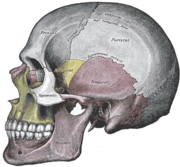Skull
|
|
A skull, or cranium, is a bony structure of vertebrates which serves as the general framework for a head. The skull functions to protect the brain, acting as a form of natural helmet, and to support the structures of the face.
| Contents |
Humans
In humans, the adult skull is normally made up of 28 bones. Except for the mandible, all of the bones of the skull are joined together by sutures, rigid articulations permitting very little movement.
Eight bones form the neurocranium (braincase), a protective vault of bone surrounding the brain and medulla oblongata. Fourteen bones form the splanchnocranium, the bones supporting the face. Encased within the temporal bones are the six ear ossicles of the middle ear. The hyoid bone, supporting the larynx, is usually not considered as part of the skull, as it does not articulate with any other bones.
Development of the skull
The skull is a complex structure; its bones are formed both by intramembranous and endochondral ossification. The bones of the splanchnocranium and the sides and roof of the neurocranium are formed by intramembranous (or dermal) ossification, while the bones supporting the brain (the occipital, sphenoid, temporal, and ethmoid) are largely formed by endochondral ossification.
At birth, the human skull is made up of 45 separate bony elements. As growth occurs, many of these bony elements gradually fuse together into solid bone (for example, the frontal bones). The bones of the roof of the skull are initially separated by regions of dense connective tissue. At birth these regions are fibrous and moveable, necessary for birth and later growth. Larger regions of connective tissue, called fontanelles, occur where certain bony elements meet. As growth and ossification progress, the connective tissue of the fontanelles is invaded and replaced by bone. The posterior fontanelle usually closes by eight weeks, but the anterior fontanelle can remain up to eighteen months. The anterior fontanelle is located at the junction of the frontal and parietal bones; it is a "soft spot" on a baby's forehead. Careful observation will show that you can count a baby's heartrate by observing his or her pulse pulsing softly through the anterior fontanelle.
Pathology
If the brain is bruised or injured it can be extremely serious. Normally the skull protects the brain from damage through its hard unyieldingness, but in some cases of head injury, there can be raised intracranial pressure through mechanisms such as a subdural haematoma. In these cases the raised intracranial pressure can cause herniation of the brain out of the foramen magnum ('coning') because there is no space for the brain to expand to—this can result in significant brain damage or death unless an urgent operation is performed to relieve the pressure. This is why patients with concussion must be watched extremely carefully.
In earlier times, a skull operation called trepanation was often performed for semi-mystical reasons and not only as an attempted life-saving technique.
The skull also contains the sinus cavities. The meninges are the membranes that separate the brain from the skull.
Although persons of East Asian descent are occasionally stereotyped as different from other ethnic groups on the basis of a variety of traits like eye shape, nose shape, hair color, and skin color, nearly all such stereotypes are incorrect and highly flawed. Among neurologists and pathologists, it is well-known that the most consistent and unique trait in East Asians is skull shape. However, this bit of knowledge is rarely discussed in public because of the need to avoid encouraging pseudoscientific theories like phrenology which attempt to connect skull shape to intelligence.
Bones of the human skull
Cranial bones
Facial bones
- mandible
- maxilla (2)
- palatine bone (2)
- zygomatic bone (2)
- nasal bone (2)
- lacrimal bone (2)
- vomer bone
- inferior nasal conchae (2)
Ear ossicles
Other features of the skull
Foramina of skull base
The following is a list of holes, or foramina, in the base of the skull and what goes through each of them. Arranged from anterior to posterior:
- foramen caecum - emissary vein to superior sagittal sinus
- foramina of cribriform plate - olfactory nerve bundles
- posterior ethmoidal foramen - posterior ethmoidal artery, vein and nerve
- optic canal - optic nerve (II), ophthalmic artery
- superior orbital fissure
- oculomotor nerve (III)
- trochlear nerve (IV)
- lacrimal, frontal and nasociliary branches of ophthalmic nerve (V1)
- abducens nerve (VI)
- superior ophthalmic vein
- foramen rotundum - maxillary nerve (V2)
- foramen ovale
- mandibular nerve (V3)
- accessory meningeal artery
- lesser petrosal nerve (occasionally)
- foramen spinosum
- foramen lacerum
- hiatus of canal of lesser petrosal nerve
- hiatus of canal of greater petrosal nerve
- internal acoustic meatus
- facial nerve (VII)
- vestibulocochlear nerve (VIII)
- labyrinthine artery
- jugular foramen
- hypoglossal canal - hypoglossal nerve (XII)
- foramen magnum
- medulla oblongata
- vertebral arteries
- meningeal branches of vertebral arteries
- spinal roots of accessory nerves
Notable sutures
Most sutures are named for the bones they articulate, but some have special names of their own.
- Sagittal - along the midline, between parietal bones
- Coronal - between the frontal and parietal bones
- Lambdoidal - between the parietals and the occipital bone
- Squamosal - between the parietal and the temporal bone
- Metopic - between the two frontal bones, prior to the fusion of the two into a single bone


